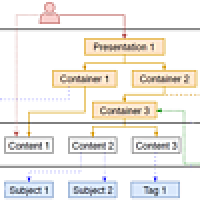A Conceptual Framework and Content Model for Next Generation Presentation Solutions

Mainstream presentation tools such as Microsoft PowerPoint were originally built to mimic physical media like photographic slides and still exhibit the same characteristics. However, the state of the art in presentation tools shows that more recent solutions start to go beyond the classic presentation paradigms. For instance, presentations are becoming increasingly non-linear, content is quickly evolving beyond simple text and images and the way we author our presentations is becoming more collaborative. Nevertheless, existing presentation content models are often based on assumptions that do not apply to the current state of presentations any more, making them incompatible for some use cases and limiting the potential of end-user presentation solutions. In order to support state-of-the-art presentation functionality, we rethink the concept of a presentation and introduce a conceptual framework for presentation content. We then present a new content model for presentation solutions based on the Resource-Selector-Link (RSL) hypermedia metamodel. We further discuss an implementation of our model and show some example use cases. We conclude by outlining how design choices in the model address currently unmet needs with regards to extensibility, content reuse, collaboration, semantics, user access management, non-linearity, and context awareness, resulting in better support for the corresponding end-user functionality in presentation tools.
Publication Reference
Roels, R. and Signer, B.: "A Conceptual Framework and Content Model for Next Generation Presentation Solutions", Proceedings of the ACM on Human-Computer Interaction (PACMHCI), 2019



